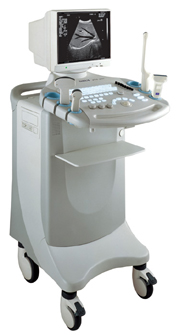Medical Ultrasound Imaging
Thursday, 9 May 2024
'Ultrasonic Power' p2 Searchterm 'Ultrasonic Power' found in 13 articles 1 term [ • ] - 6 definitions [• ] - 6 booleans [• ]Result Pages : •
Due to the absorption of ultrasound, heating of tissue (including bone) can occur. For this reason, the sonographer should follow the ALARA principle to minimize the potential for ultrasonic heating of tissue during for example M-mode ultrasound. The thermal effect of Doppler ultrasound flow examinations is significantly greater.
See also Thermal Index and Ultrasonic Power. •
Conventional, CT and MR imaging technologies are limited in their availability, to depict soft tissue, or to show dynamic activity, like cardiac muscle contractility and blood flow. Easy applicability, real-time sonography and biopsy facilitation are important advantages in veterinarian medicine. Veterinary ultrasound has a very high sensitivity to show the composition of soft tissues, but the low specificity is a disadvantage. High ultrasound system performance includes Doppler techniques, contrast enhanced ultrasound, 3D ultrasound, and tissue harmonic imaging to improve resolution. Technical and physical requirements of veterinary ultrasound are the same as in human ultrasonography. The higher the sound frequency, the better the possible resolution, but the poorer the tissue penetration. Image quality is depended of the ultrasound equipment. For example, a 10 MHz transducer is excellent for imaging of superficial structures; a 3.5 or 5.0 megahertz transducer allows sufficient penetration to see inner structures like the liver or the heart. In addition, the preparation and performing of the examination is similar to that of humans. The sound beam penetrates soft tissue and fat well, but gas and bone impede the ultrasonic power. Fluid filled organs like the bladder are often used as an acoustic window, and an ultrasound gel is used to conduct the sound beam. •  From SIUI Inc.;
From SIUI Inc.;'Dedicated to ultrasound industry, Shantou Institute of Ultrasonic Instruments, Inc. (SIUI) has launched Apogee 3500, the Digital Color Doppler Ultrasound Imaging System. With latest imaging technologies, high-definition image quality and excellent practical functions, the Apogee 3500 offers optimal solutions for clinical ultrasonic examination.' 'The Apogee 3500 is available with many high-density, super broadband and multi-frequency probes, such as convex, micro-convex, linear, vaginal, rectal and phased array probes, which are widely applied for different clinical diagnoses, including abdomen (liver, kidney, gall-bladder, pancreas), gynecology (uterus, ovary), obstetrics (early pregnancy, basic OB, complete OB, multi gestation, fetal echo), cardiology (adult and pediatric cardiology), small parts (thyroid, galactophore, testicles, neonate), peripheral vascular and prostate.'
Device Information and Specification
CONFIGURATION
Normal system, color - gray scale(256)
Linear, convex and phased array
PROBES STANDARD
2.0 MHz ~ 12.0 MHz, broad band, tri-frequency
B-mode (B, 2B, 4B), M-mode, B/M-mode, real-time compound imaging, panoramic imaging, trapezoidal imaging (linear probes), spectrum Doppler (PWD and CWD), color Doppler flow imaging (CDFI), color power angio (CPA), tissue harmonic imaging (THI)
IMAGING OPTIONS
Real-time ZOOM, zoom rate and position selectable
OPTIONAL PACKAGE
H*W*D m
1.29 * 0.52 * 0.75
WEIGHT
110 kg
POWER REQUIREMENT
AC 220V/110V, 50Hz/60Hz
POWER CONSUMPTION
0.6 KVA
•
Rayleigh scattering is the backscattering of ultrasound from blood. The echoes detected from blood are created through interference between scattered wavelets from numerous point scatterers. Rayleigh Scatterers are objects whose dimensions are much less than the ultrasound wavelength. Rayleigh scattering increases with frequency raised to the 4th power and provides much of the diagnostic information from ultrasound. Doubling the ultrasonic frequency makes the echoes from blood 16 times as strong. The intensity of the backscattered echoes is proportional to the total number of scatterers, which means that the echo amplitude is proportional to the square root of the total number of scatterers. At normal blood flow, the number of point scatterers in blood is proportional to the number of red blood cells. When blood flow is turbulent, or accelerating fast (e.g. in a stenosis), the number of inhomogeneities in the red blood cell concentration will increase. See also Scattered Echo. •
The transorbital window allow to insonate ophthalmic artery and ipsilateral carotid siphon through the eye. It is also possible to use the transorbital entrance to scan the middle and anterior cerebral arteries, if it is impossible through the transtemporal window. The patient is asked to remove any contact lenses prior to examination and is instructed to close the eyes. The power output of the Doppler instrument has to be decreased to 10-20% to reduce the ultrasonic exposure of the eye. See also Transcranial Doppler, Ultrasound Safety. Result Pages : |
Medical-Ultrasound-Imaging.com
former US-TIP.com
Member of SoftWays' Medical Imaging Group - MR-TIP • Radiology TIP • Medical-Ultrasound-Imaging
Copyright © 2008 - 2024 SoftWays. All rights reserved.
Terms of Use | Privacy Policy | Advertise With Us
former US-TIP.com
Member of SoftWays' Medical Imaging Group - MR-TIP • Radiology TIP • Medical-Ultrasound-Imaging
Copyright © 2008 - 2024 SoftWays. All rights reserved.
Terms of Use | Privacy Policy | Advertise With Us
[last update: 2023-11-06 01:42:00]




